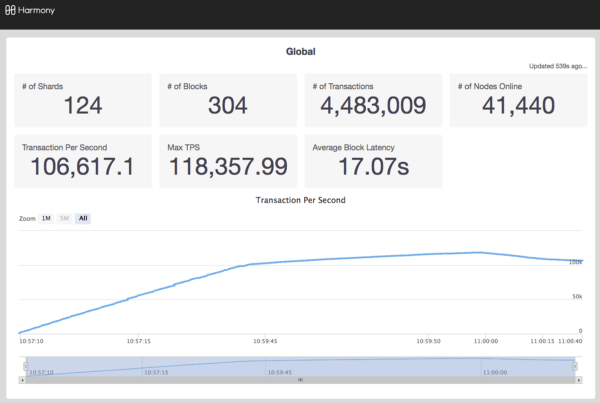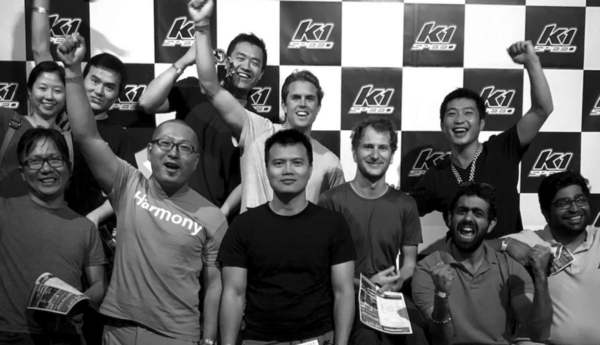
Harmony Project Update 2018-09
April 06, 2019
Dear investors and friends,
Since our last newsletter, we have achieved significant technical milestones and planned a full outreach tour in Asia.
Here’re the event highlights of our four-city hops (see our tour flyer):
- 9/18–9/21 in Singapore (join our wechat SG group): Consensus Conference.
- 9/21–9/27 in Beijing (BJ group): technical discussion at Tsinghua, fireside chat with Startup Grind, “Scaling Web 3” tech talk, TGI-blockchain entrepreneur gathering.
- 9/27–10/1 in Shanghai (SH group): Meetups with Angelhacks & Xnode accelerator.
- 9/30–10/3 in Hong Kong (HK group): Joint events with Hyperion Maps & iHouse Token.

Our internal testnet has recently achieved 118,357 transactions per second on 41,440 machines across Amazon, Google, Microsoft cloud. Our consensus algorithm now features all core features of OmniLedger, including ByzCoinX PBFT, cross shard transactions, CoSi multi-signatures, state pruning, and block bootstrapping. We extensively studied the latest research paper RapidChain (and its excellent slides). We will soon integrate with RapidChain’s improvements including P2P Kademlia routing, Cuckoo reconfiguration, erasure code for gossiping, and distributed bootstrapping.
Michael Arrington (Techcrunch News and XRP Capital founder) visited our old garage office in June and has been very supportive of our project. Last week Michael visited again to see the full team and blogged, “This is probably the hottest pre-funded crypto startup in the valley right now, and investors are clamoring for introductions.”

We completed our branding and new website design. See this branding guidefor the strategy and voice behind our positioning, “Harmony is building an open consensus platform to 1,000x the world’s decentralized economies.” The new site harmony.one (ready by 9/22) now features FAQs and our updated roadmap.
We continued engaging our academic and general communities. On 9/19, we’ll be giving a technical lecture at BitTiger (the largest Chinese tech community in Silicon Valley; see our slides) on scaling consensus algorithms; and, on 10/18, at Stanford Law School’s CodeX Program on computational law. We also attended IACR’s Crypto in Santa Barbara with many technical presentations including Algorand and ThunderCore.
On 10/11, at Cryptoeconomics and Security Conference (CESC) by Blockchain at Berkeley, we’ll be speaking (along with Dfinity and Oasis Labs) on “Scaling Consensus with Systems and Language Design”. Our talk abstract is “To build decentralized AI marketplaces with millions tx/sec, an open consensus platform must scale end-to-end from protocols to systems and smart contract verification. We’ll focus on integrating the latest research results and putting them to production with 100k nodes.”

We made an engineering planfor the simulation and optimization of the Harmony network, detailing our roadmap for reference implementations, standardized network parameters and quantitative models. Jepsen’s security analysis on Tendermint was inspirational, discovering multiple bugs on its key-value store, goleveldb and write-ahead logs.
We follow closely the latest developments in AI data marketplaces. Two recent works stand out. The first work by Oasis Labs, Sterling: A Privacy-Preserving Data Marketplace, features pricing, differential privacy and efficient model training. The second by Bryan Ford’s Lab, Calypso: Auditable Sharing of Private Data over Blockchains, features dynamic identities and access revocation.
We have completed the setup of our foundation for issuing Harmony tokens. Our next fund raising round will open shortly. To engage a broad community, we intend to allocate a broad set of investors in many geographies. AngelList ex-General Council and Republic Crypto CEO, Kendrick Nguyen, visited; we share the vision of bringing investment opportunities to the masses.
Our new pitch deck is ready, expanding our strategies on smart contracts, formal verification, research roadmap and decentralized applications. In particular, we’re exploring Certik’s verification, Zillqa’s games, Ekiden’s poker in Rust, ThunderCore’s kitties, and fomo3d.
Besides Picolo (storage and structured access), Hyperion (decentralized map) also becomes our launch partner to explore scalable protocols with Harmony. We published on a blog “Measure of a blockchain: getting metrics that matter,” explaining why stress tests, randomized transactions, standard ratios, minimum requirements, steady state behavior, and cost are keys to blockchain performance reports.
Prof. Thang Dinh (billion-scale graph mining, network security, approximation algorithms) has begun collaborating with us on network optimization. Prof. Lau and Prof. Liu visited us for three days to update us onNeuroLedger and to explore ideas on data marketplaces.
For hiring, we’re focusing on systems engineers with Rust and kernel experience; on protocol researchers with expertise in consensus algorithms, fault tolerant design and high performance; and, on compiler writers with OCaml and Coq skills for our smart contracts.
Albert Einstein writes, “In art, and in the higher ranges of science, there is a feeling of harmony which underlies all endeavor. There is no true greatness in art or science without that sense of harmony.” Lastly, we need your help on the following:
- Shoutouts for our events in Singapore, Beijing, Shanghai and Hong Kong.
- Hiring systems engineers, protocol researchers and compiler writers.
- Sharing this https://harmony.one/newsletter with the public!
Stephen Tse
Harmony CEO